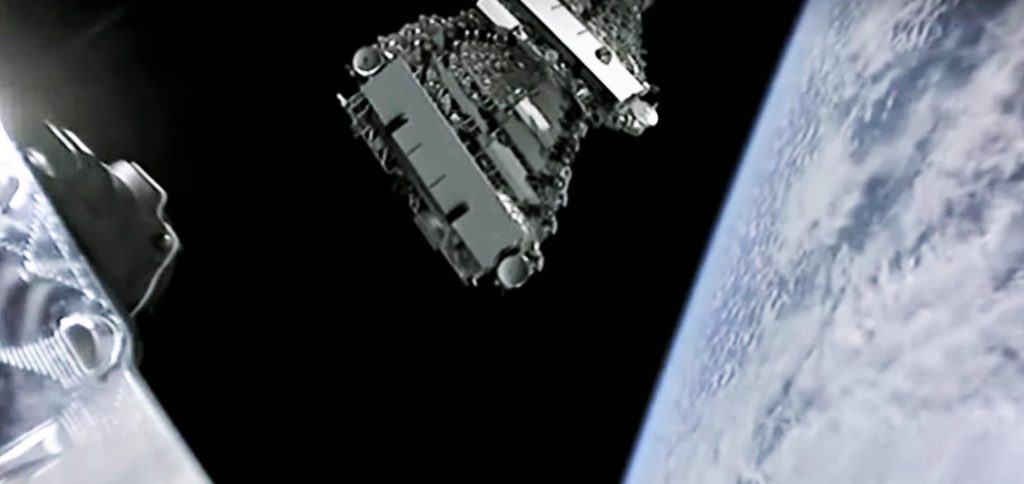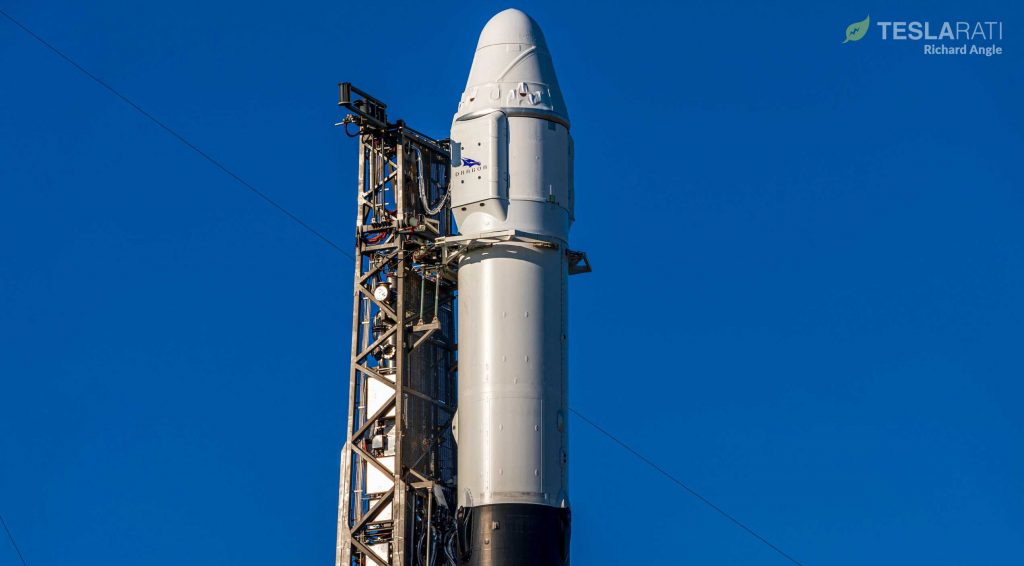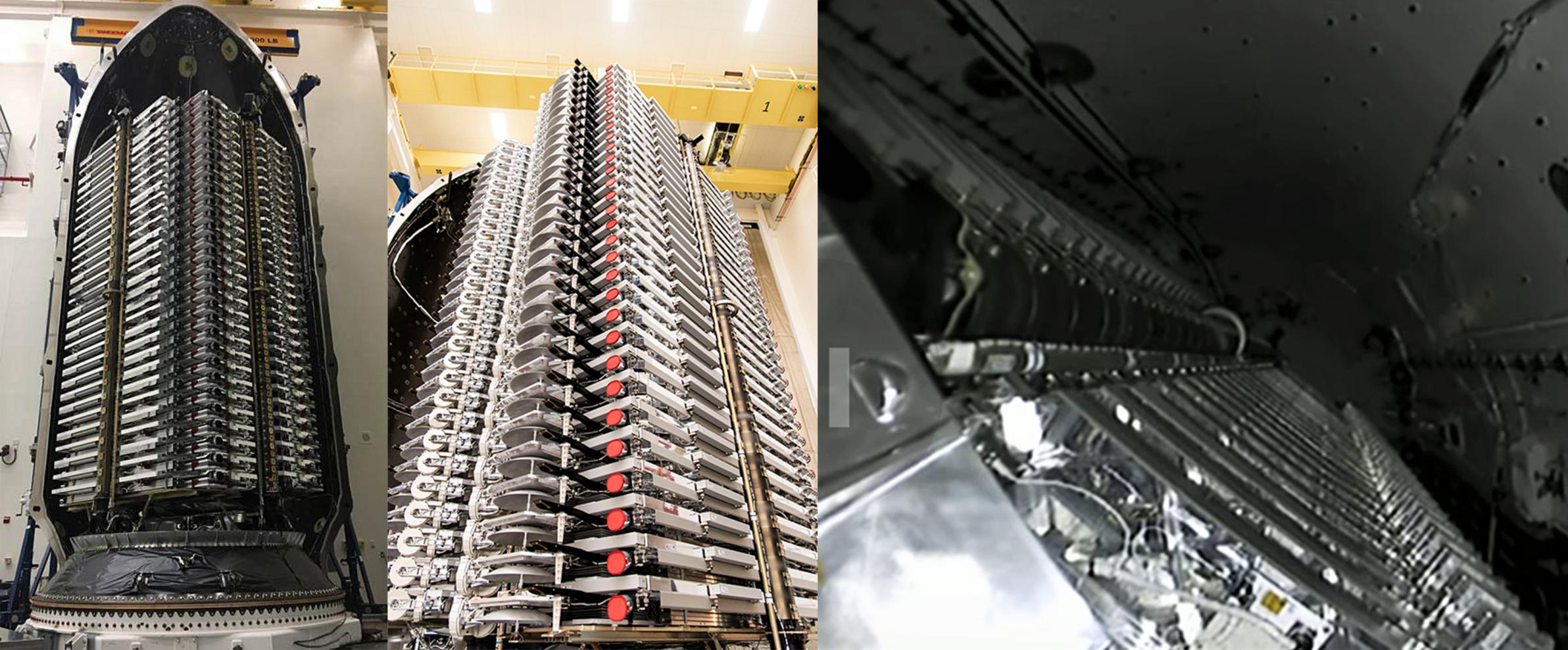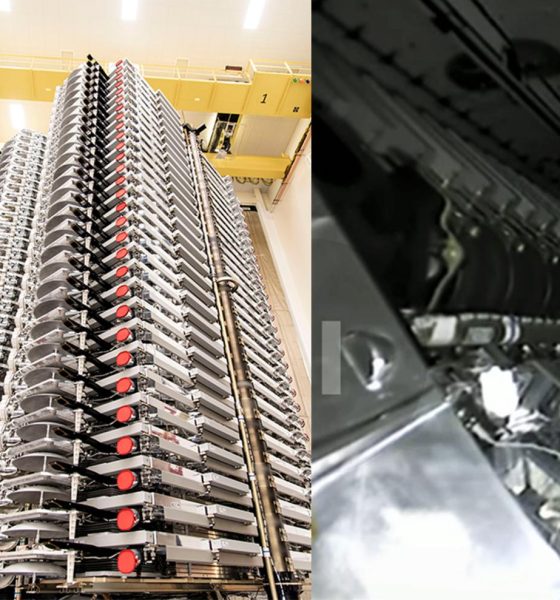CEO Elon Musk says SpaceX is churning out Starlink satellites faster than it can launch them, the best sign yet that the company is having some amazing success in what is already the most productive satellite factory in history.
Since SpaceX first revealed its radical flat-satellite Starlink design, stacking approach, and deployment mechanism back in May 2019, the company has successfully launched an incredible 300 satellites, ~290 of which are still functioning as intended. At this point, that means that Starlink is likely the largest satellite constellation in history by a factor of two, crushing the second largest’s ~150 satellites. Perhaps even more significant is the mass of SpaceX’s nine-month-old constellation, currently standing at more than 75 metric tons (165,000 lb) of satellites in orbit.
Despite the already awe-inspiring scale of SpaceX’s satellite internet constellation, the company’s Starlink factory is already so successful that the company is now unable to launch the spacecraft as quickly as they’re built. Given that SpaceX has maintained an average of ~1.3 Starlink launches per month since November 2019, many of which suffered significant delays as a result of weather or minor hardware issues, this likely means that SpaceX is building dozens more satellites than it can launch, probably creating its own internal launch manifest backlog as those surplus spacecraft pile up.
Considering the fact that SpaceX has gone from two prototype spacecraft to the proud owner of the largest satellite constellation in history in less than nine months, the fact that the company’s Starlink factory is already outpacing its launch capacity is arguably a good sign. While it’s likely that weather and hardware-related launch delays on the last few Starlink missions have made it harder than expected to stick to plans for an average of two Starlink launches per month, SpaceX isn’t falling that short of its classically lofty ambitions (a bit less than one Starlink launch every two weeks).

SpaceX may now be the first company in history to chronically suffer from its factories building more satellites than it can launch in a given time frame. In those terms, a surplus of flight-ready satellites is actually a highly desirable “problem” to have. Competitor OneWeb, for example, was forced to delay its first 34-satellite launch by two months after its new Florida factory suffered several production delays.
SpaceX, on the other hand, has to build almost twice as many satellites per launch, has effectively launched 35% of OneWeb’s entire constellation (~650 satellites) in the last three months alone, and still has an apparent backlog of satellites ready to head to orbit. As of March 3rd, SpaceX’s fifth launch of 60 upgraded Starlink v1.0 satellites and sixth launch overall (Starlink V1 L5 or Starlink-6) is scheduled to lift off no earlier than March 14th after slipping from February 14th, March 4th, and March 11th. The mission’s most recent delays were caused by an issue discovered in the Falcon 9 second stage assigned to launch Cargo Dragon’s CRS-20 mission, triggering SpaceX to swap it with Starlink V1 L5’s unaffected second stage.

After Starlink V1 L5, SpaceX has more batches of 60 Starlink satellites that – given Musk’s comments – might already be stacked and ready for flight, both of which could potentially fly in March or April. In the midst of its Starlink launch ambitions, SpaceX has scheduled Florida’s first polar launch in half a century on March 30th, followed by a historic US Air Force launch and landing no earlier than (NET) April 27th.
If Cargo Dragon successfully lifts off this Friday, SpaceX will reach an average of ~1.9 weeks per launch, a cadence that – if maintained – would set the company up for at least 27 launches in 2020. With room for improvement after several weather-related days: so far, so good.
Check out Teslarati’s Marketplace! We offer Tesla accessories, including for the Tesla Cybertruck and Tesla Model 3.

News
Tesla FSD fleet is nearing 7 billion total miles, including 2.5 billion city miles
As can be seen on Tesla’s official FSD webpage, vehicles equipped with the system have now navigated over 6.99 billion miles.

Tesla’s Full Self-Driving (Supervised) fleet is closing in on almost 7 billion total miles driven, as per data posted by the company on its official FSD webpage.
These figures hint at the massive scale of data fueling Tesla’s rapid FSD improvements, which have been quite notable as of late.
FSD mileage milestones
As can be seen on Tesla’s official FSD webpage, vehicles equipped with the system have now navigated over 6.99 billion miles. Tesla owner and avid FSD tester Whole Mars Catalog also shared a screenshot indicating that from the nearly 7 billion miles traveled by the FSD fleet, more than 2.5 billion miles were driven inside cities.
City miles are particularly valuable for complex urban scenarios like unprotected turns, pedestrian interactions, and traffic lights. This is also the difference-maker for FSD, as only complex solutions, such as Waymo’s self-driving taxis, operate similarly on inner-city streets. And even then, incidents such as the San Francisco blackouts have proven challenging for sensor-rich vehicles like Waymos.
Tesla’s data edge
Tesla has a number of advantages in the autonomous vehicle sector, one of which is the size of its fleet and the number of vehicles training FSD on real-world roads. Tesla’s nearly 7 billion FSD miles then allow the company to roll out updates that make its vehicles behave like they are being driven by experienced drivers, even if they are operating on their own.
So notable are Tesla’s improvements to FSD that NVIDIA Director of Robotics Jim Fan, after experiencing FSD v14, noted that the system is the first AI that passes what he described as a “Physical Turing Test.”
“Despite knowing exactly how robot learning works, I still find it magical watching the steering wheel turn by itself. First it feels surreal, next it becomes routine. Then, like the smartphone, taking it away actively hurts. This is how humanity gets rewired and glued to god-like technologies,” Fan wrote in a post on X.
News
Tesla starts showing how FSD will change lives in Europe
Local officials tested the system on narrow country roads and were impressed by FSD’s smooth, human-like driving, with some calling the service a game-changer for everyday life in areas that are far from urban centers.

Tesla has launched Europe’s first public shuttle service using Full Self-Driving (Supervised) in the rural Eifelkreis Bitburg-Prüm region of Germany, demonstrating how the technology can restore independence and mobility for people who struggle with limited transport options.
Local officials tested the system on narrow country roads and were impressed by FSD’s smooth, human-like driving, with some calling the service a game-changer for everyday life in areas that are far from urban centers.
Officials see real impact on rural residents
Arzfeld Mayor Johannes Kuhl and District Administrator Andreas Kruppert personally tested the Tesla shuttle service. This allowed them to see just how well FSD navigated winding lanes and rural roads confidently. Kruppert said, “Autonomous driving sounds like science fiction to many, but we simply see here that it works totally well in rural regions too.” Kuhl, for his part, also noted that FSD “feels like a very experienced driver.”
The pilot complements the area’s “Citizen Bus” program, which provides on-demand rides for elderly residents who can no longer drive themselves. Tesla Europe shared a video of a demonstration of the service, highlighting how FSD gives people their freedom back, even in places where public transport is not as prevalent.
What the Ministry for Economic Affairs and Transport says
Rhineland-Palatinate’s Minister Daniela Schmitt supported the project, praising the collaboration that made this “first of its kind in Europe” possible. As per the ministry, the rural rollout for the service shows FSD’s potential beyond major cities, and it delivers tangible benefits like grocery runs, doctor visits, and social connections for isolated residents.
“Reliable and flexible mobility is especially vital in rural areas. With the launch of a shuttle service using self-driving vehicles (FSD supervised) by Tesla in the Eifelkreis Bitburg-Prüm, an innovative pilot project is now getting underway that complements local community bus services. It is the first project of its kind in Europe.
“The result is a real gain for rural mobility: greater accessibility, more flexibility and tangible benefits for everyday life. A strong signal for innovation, cooperation and future-oriented mobility beyond urban centers,” the ministry wrote in a LinkedIn post.
News
Tesla China quietly posts Robotaxi-related job listing
Tesla China is currently seeking a Low Voltage Electrical Engineer to work on circuit board design for the company’s autonomous vehicles.

Tesla has posted a new job listing in Shanghai explicitly tied to its Robotaxi program, fueling speculation that the company is preparing to launch its dedicated autonomous ride-hailing service in China.
As noted in the listing, Tesla China is currently seeking a Low Voltage Electrical Engineer to work on circuit board design for the company’s autonomous vehicles.
Robotaxi-specific role
The listing, which was shared on social media platform X by industry watcher @tslaming, suggested that Tesla China is looking to fill the role urgently. The job listing itself specifically mentions that the person hired for the role will be working on the Low Voltage Hardware team, which would design the circuit boards that would serve as the nervous system of the Robotaxi.
Key tasks for the role, as indicated in the job listing, include collaboration with PCB layout, firmware, mechanical, program management, and validation teams, among other responsibilities. The role is based in Shanghai.
China Robotaxi launch
China represents a massive potential market for robotaxis, with its dense urban centers and supportive policies in select cities. Tesla has limited permission to roll out FSD in the country, though despite this, its vehicles have been hailed as among the best in the market when it comes to autonomous features. So far, at least, it appears that China supports Tesla’s FSD and Robotaxi rollout.
This was hinted at in November, when Tesla brought the Cybercab to the 8th China International Import Expo (CIIE) in Shanghai, marking the first time that the autonomous two-seater was brought to the Asia-Pacific region. The vehicle, despite not having a release date in China, received a significant amount of interest among the event’s attendees.










